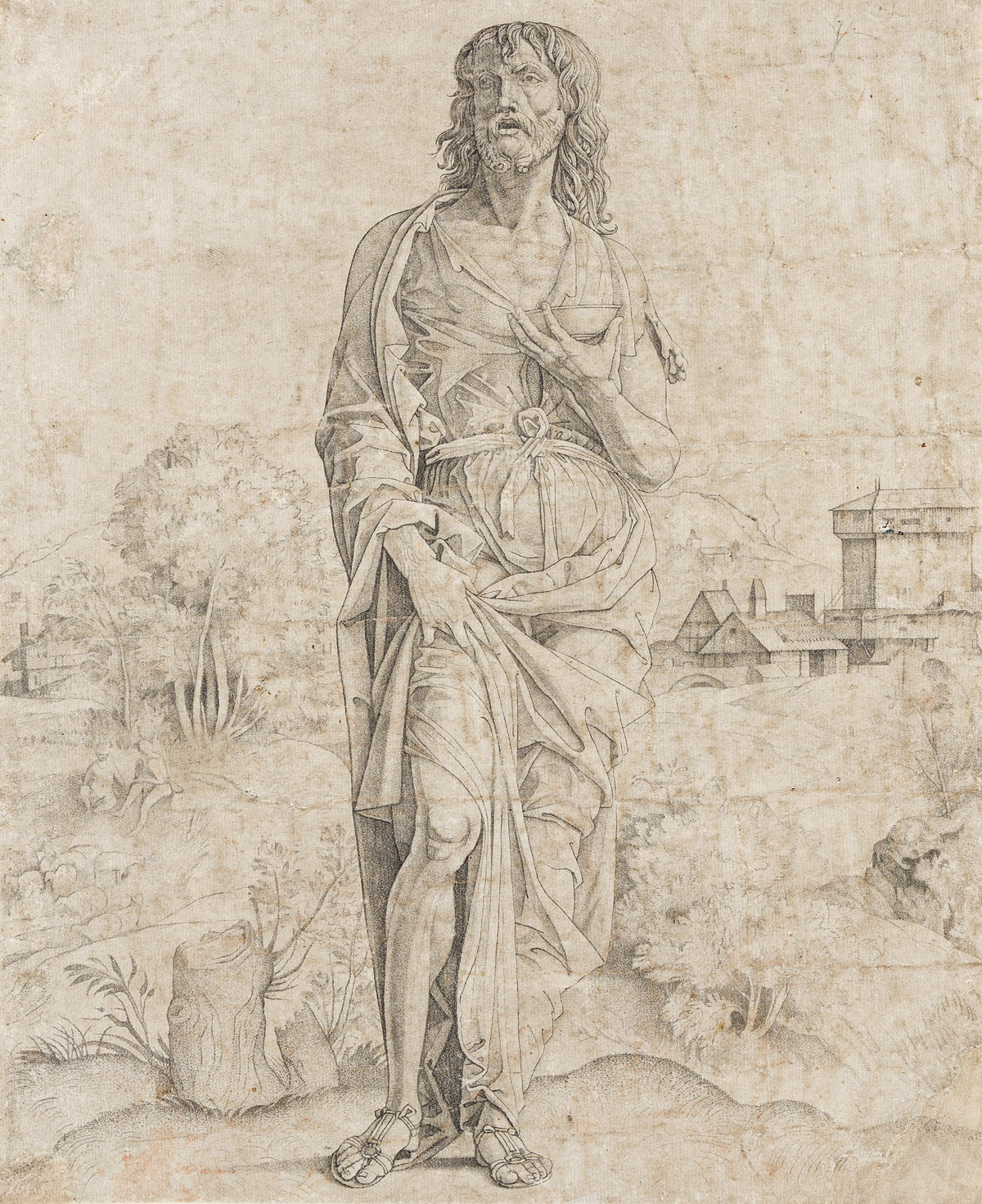Sale 2602 - Lot 4
Unsold
Estimate: $ 8,000 - $ 12,000
GIULIO CAMPAGNOLA
Saint John the Baptist.
Engraving and stipple-engraving, circa 1505. 283x232 mm; 11 1/4x9 1/4 inches. Bull's head with a cross and the letters S M in a circle watermark (Briquet 15396, which dates from circa 1500-10 and is found on imprints from Treviso and Innsbruck at this time). Trimmed on or just inside the plate mark on three sides and inside the plate mark in the upper blank space, with the subject preserved. A good and early impression of this exceedingly scarce, Italian Renaissance engraving.
We have found only one other impression at auction in the past 30 years, a later impression with a watermark from the second half of the 16th century (sold Christie's, London, March 31, 2010, lot 36).
Campagnola's (1482-1515) importance as an early printmaker and Renaissance artist owes to his introduction of the stipple-engraving technique, which produced shading using dots made by the point of the graver on the metal plate. According to Landau and Parshall, "The innovation allowed a much greater range of tone from white to black, and at the same time a more controllable graduated transition between lighter and darker areas of the image. The disadvantages of the technique were that it was immensely more time-consuming than ordinary engraving, that the dots produced, unless of sufficient size, would wear down quite quickly, and, finally, that it was extremely difficult to freshen-up a tired-looking plate by re-engraving it--a common strategy in printmaking. Whereas pushing the burin along the existing, shallowed grooves was a well-tried and effective method of freshening worn plates, hitting again the myriad of of existing dots was an impossible task, and creating new dots would easily produce patches of ink where new and old dots joined together. This is precisely why there are no known instances of Giulio's plates being reworked in later states by retouching the dotted areas of the image," (Landau and Parshall, The Renaissance Print, New Haven/London, 1994, page 261).
It has been widely accepted that Campagnola adapted the figure of Saint John the Baptist from a now lost drawing by Andrea Mantegna (1431-1506) while the landscape was supplied contemporaneously by Giorgione (circa 1477/78-1510) working closely with the Campagnola. There is an ink drawing now in the Louvre, Paris, with the landscape rendered in reverse of the print, by Giorgione, that is believed to be the source for Campagnola's landscape in Saint John the Baptist. It appears that Giorgione intentionally left the space for the figure blank in his landscape drawing, as Campagnola already had his figure from a design by Mantegna engraved on the plate, and that sometime thereafter none other than Titian (1488-1576) drew in his own representation of Saint John the Baptist on the Louvre, Paris sheet. Bartsch 3; Hind 12.
Saint John the Baptist.
Engraving and stipple-engraving, circa 1505. 283x232 mm; 11 1/4x9 1/4 inches. Bull's head with a cross and the letters S M in a circle watermark (Briquet 15396, which dates from circa 1500-10 and is found on imprints from Treviso and Innsbruck at this time). Trimmed on or just inside the plate mark on three sides and inside the plate mark in the upper blank space, with the subject preserved. A good and early impression of this exceedingly scarce, Italian Renaissance engraving.
We have found only one other impression at auction in the past 30 years, a later impression with a watermark from the second half of the 16th century (sold Christie's, London, March 31, 2010, lot 36).
Campagnola's (1482-1515) importance as an early printmaker and Renaissance artist owes to his introduction of the stipple-engraving technique, which produced shading using dots made by the point of the graver on the metal plate. According to Landau and Parshall, "The innovation allowed a much greater range of tone from white to black, and at the same time a more controllable graduated transition between lighter and darker areas of the image. The disadvantages of the technique were that it was immensely more time-consuming than ordinary engraving, that the dots produced, unless of sufficient size, would wear down quite quickly, and, finally, that it was extremely difficult to freshen-up a tired-looking plate by re-engraving it--a common strategy in printmaking. Whereas pushing the burin along the existing, shallowed grooves was a well-tried and effective method of freshening worn plates, hitting again the myriad of of existing dots was an impossible task, and creating new dots would easily produce patches of ink where new and old dots joined together. This is precisely why there are no known instances of Giulio's plates being reworked in later states by retouching the dotted areas of the image," (Landau and Parshall, The Renaissance Print, New Haven/London, 1994, page 261).
It has been widely accepted that Campagnola adapted the figure of Saint John the Baptist from a now lost drawing by Andrea Mantegna (1431-1506) while the landscape was supplied contemporaneously by Giorgione (circa 1477/78-1510) working closely with the Campagnola. There is an ink drawing now in the Louvre, Paris, with the landscape rendered in reverse of the print, by Giorgione, that is believed to be the source for Campagnola's landscape in Saint John the Baptist. It appears that Giorgione intentionally left the space for the figure blank in his landscape drawing, as Campagnola already had his figure from a design by Mantegna engraved on the plate, and that sometime thereafter none other than Titian (1488-1576) drew in his own representation of Saint John the Baptist on the Louvre, Paris sheet. Bartsch 3; Hind 12.

Exhibition Hours
Exhibition Hours
Aliquam vulputate ornare congue. Vestibulum maximus, libero in placerat faucibus, risus nisl molestie massa, ut maximus metus lectus vel lorem.


